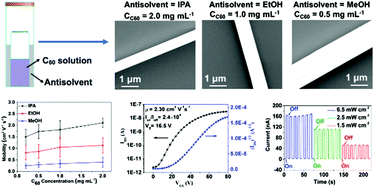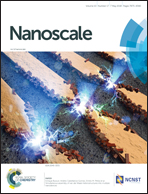Antisolvent-assisted controllable growth of fullerene single crystal microwires for organic field effect transistors and photodetectors†
Abstract
There are only a few reported methods by which the size and morphology of organic single crystals for high-performance organic field-effect transistors (OFETs) or other devices can be controlled. Here, a facile solution-processed antisolvent vapor diffusion method was employed to grow millimeter-length C60 single crystal microwires directly in solution. The size of the microwires can be controllably varied via the C60 concentration and/or the choice of antisolvent. OFETs fabricated from the as-produced microwires exhibit mobilities as high as 2.30 cm2 V−1 s−1. A clear relationship between the crystal preparation conditions and device performance is revealed whereby it is observed that the lower the evaporation rate of antisolvent and/or the higher the C60 concentration, the higher the device performance. Photodetectors based on our microwires give a responsivity that is an order of magnitude higher than those grown by drop-casting methods. This study provides a facile method for the crystal engineering of size-tunable millimeter-length C60 single crystals, and revealed the important influences of the antisolvent on the C60 crystal size and the performance of devices based on them. We believe that our processing approach can be further exploited for a broad range of other organic semiconductors to achieve desirable single crystal size and morphology and thus obtain desirable OFETs and photodetector performance.



 Please wait while we load your content...
Please wait while we load your content...